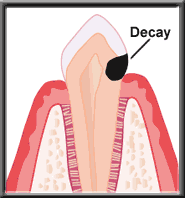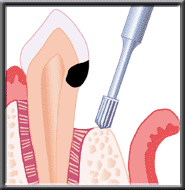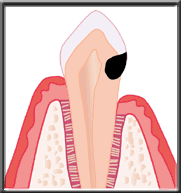Crown Lengthening
|
If the dentist is unable to reach decay that is deep under the gum, the tooth will be lost. As a rule, simply trimming back the gum is not sufficient. Rather, the periodontist must reflect a flap, trim back the bone to allow for access to the decay, and then suture the gum back at the lower level. Sufficient bone must be removed to allow room below the decay for the gum to reattach to the tooth.
Most crown lengthening procedures are very straightforward, and there is minimal post-operative discomfort. Sutures and dressing are removed after about 1 week. If a crown is to be placed in a cosmetic area, the restorative dentist should wait12 weeks following crown lengthening before taking final impressions. This ensures that the gum, is in its final position. If the margin of the crown is placed at the gum level before final healing, the results may be compromised. A temporary crown can be placed two weeks after surgery if the patient desires to cover the exposed root during this healing period. |





 The part of the tooth that is seen above the gum is called the clinical crown. When not enough of the clinical crown is showing, the gum must be moved up or down the root to expose more tooth. This is called crown lengthening. There are two situations in which crown lengthening is commonly performed: to improve appearance, and to allow a dentist better access to decay or a fractured tooth.
The part of the tooth that is seen above the gum is called the clinical crown. When not enough of the clinical crown is showing, the gum must be moved up or down the root to expose more tooth. This is called crown lengthening. There are two situations in which crown lengthening is commonly performed: to improve appearance, and to allow a dentist better access to decay or a fractured tooth.


